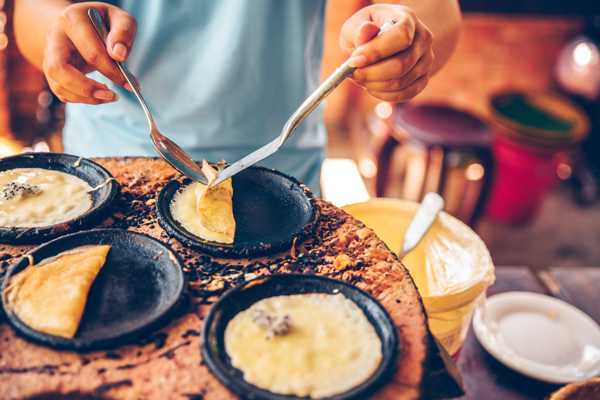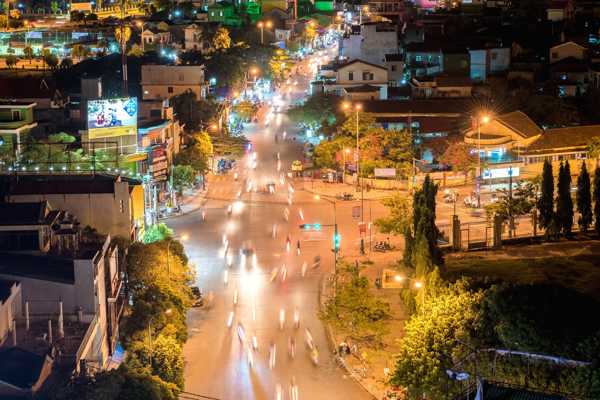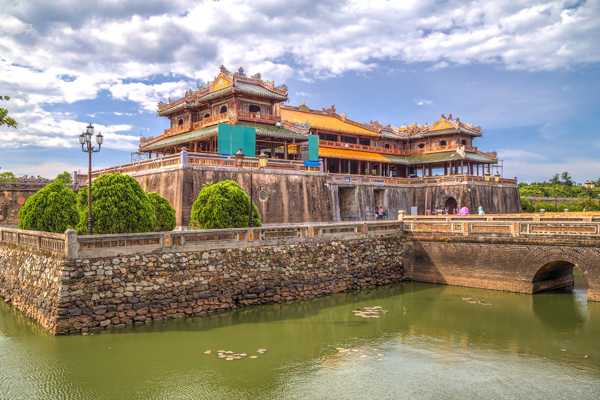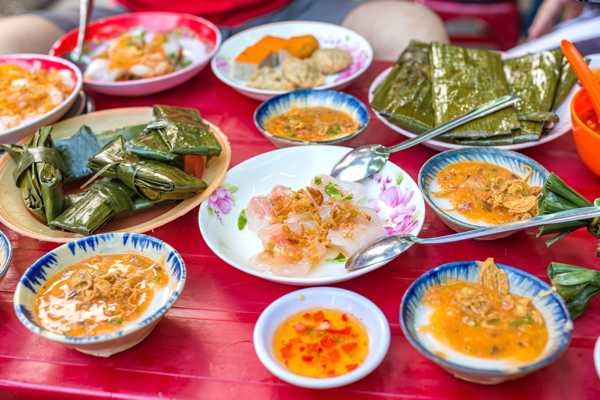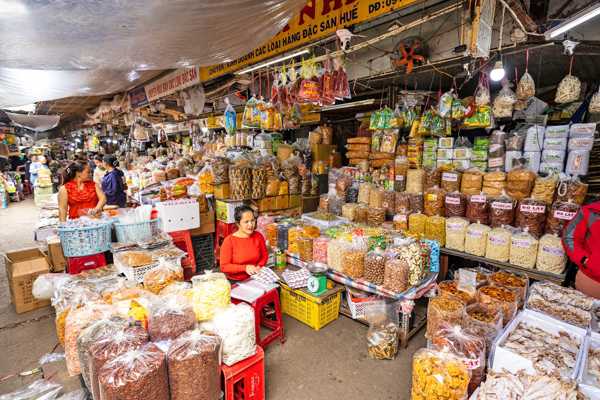The best things to do in Hue comprise well-preserved remnants of the Nguyen Dynasty, royal tombs, and ornate pagodas, most of which are easily accessible on foot or by bicycle. Once the capital of Vietnam between 1802 and 1945, the city was ruled by 10 emperors of the Nguyen Dynasty before its last ruler abdicated the throne in 1945 in favour of Ho Chi Minh’s communist government in Hanoi.
For anyone interested in the cultural history of Vietnam, Hue is a goldmine of tombs, pagodas, castles and ruins. Set overlooking the expansive Perfume River, a vast majority of these ancient buildings have managed to survive violent wars throughout the years, which led to UNESCO listing them as World Cultural Heritage sites. It attracts millions of visitors from all over the world thanks to its status as an epicentre of historical and cultural structures.
What are the best things to do in Hue?
- Histoire
- Photographie
Afficher plus d’infosThe Hue Imperial City features hundreds of monuments dating back to the early 19th century. Set along the northern bank of the Perfume River, the complex comprises the Forbidden Purple City, royal tombs, pagodas, temples, royal quarters, a library, and a museum.
Also called the Complex of Hue Monuments, this UNESCO World Heritage site hosts daily cultural performances at 9 am, 10 am, 2.30 pm and 3.30 pm. There is an entrance fee, which combines visits to the Hue Imperial City and the Hue Museum of Royal Antiquities. The Hue Imperial City is a must-visit for any visitor to Central Vietnam.
Emplacement : Thanh Pho Hue, Thua Thien Hue, Vietnam
Ouverture : Daily from 8 am to 5.30 pm
Carte- 2
Thien Mu Pagoda

- Histoire
- Photographie
Thien Mu Pagoda is set atop a hill just outside Hue City Centre, offering breathtaking views of the Perfume River and Hue Imperial City. One of its standout features is a 21-metre-tall octagonal tower called Thap Phuoc Duyen, which was built in 1844 under the reign of Emperor Thieu Tri.
The main sanctuary houses wooden sculptures of temple guardians, gold-plated Buddha statues, and a 2-tonne bell cast in 1710. Thien Mu Pagoda was also the home monastery of Buddhist monk Thich Quang Duc, who shocked the whole world when he self-immolated in 1963 in protest against the persecution of Buddhists by the South Vietnamese government.
Emplacement : Huong Hoa, Thanh Pho Hue, Thua Thien Hue 532761, Vietnam
Ouverture : Daily from 8 am to 6 pm
Carte - 3
Thanh Toan Bridge

- Histoire
- Photographie
Thanh Toan Bridge is a tile-roofed footbridge similar to Hoi An’s Japanese Covered Bridge. It featues ancient Chinese and Japanese motifs, as well as ornate carvings of sacred animals. Built during the reign of Emperor Le Hien Tong (1740-1786), this wooden bridge is built over the Nhu Y River, spanning 17 metres in length.
There’s an altar commemorating its founder, Tran Thi Dao, who was the wife of a high-ranking Mandarin in the emperor’s court. Thanh Toan Bridge, set within Thanh Thuy village, is a pleasant 20-minute drive from Hue City Centre. Along the way, you’ll pass by several traditional villages, rice paddies and pagodas.
Carte - 4
The To Mieu Temple

- Histoire
- Photographie
The To Mieu Temple is part of the UNESCO-protected Complex of Hue Monuments. It was constructed by Emperor Minh Mang in 1821 in commemoration of former emperors of the Nguyen Dynasty.
This ancestral temple is one of the best-preserved structures in the complex. It houses an ornate 3-tiered pavilion, various personal items and portraits of its 10 emperors, as well as 9 dynastic urns cast between 1835 and 1836. While travellers are free to explore The To Mieu Temple, guided tours are available for those looking to know more about the history of Hue.
Emplacement : Hue Imperial City, Le Huan, Phu Hau, Thanh Pho Hue, Thua Thien Hue, Vietnam
Carte - 5
Minh Mang Tomb

- Histoire
- Photographie
Minh Mang Tomb is hailed as the most ambitious royal tomb built during the Nguyen Dynasty. You can find it along the west bank of the Perfume River, about a 30-minute drive from Hue City Centre.
Construction of the expansive tomb started in 1840 under the order of Emperor Minh Mang. It was completed 2 years later during Emperor Thieu Tri’s reign. Surrounded by landscaped lakes and canals, Minh Mang Tomb houses 40 buildings in total, including palaces, temples, terraces, and pavilions. There is a small fee to enter the complex.
Emplacement : QL49, Huong Thọ, Huong Tra, Thua Thien Hue, Vietnam
Ouverture : Daily from 7.30 am to 5 pm
Téléphone : +84 (0)234 3523 237
Carte - 6
Tu Duc Tomb

- Histoire
- Photographie
Tu Duc Tomb is one of the many royal tombs on the outskirts of the Hue Imperial City. Built between 1864 and 1867, the complex served as a summer palace for Emperor Tu Duc. Its natural hillside and riverfront landscape include a massive lake and over 50 palaces, pavilions, temples and shrines.
Tu Duc Tomb offers a relaxing ambience for visitors looking to experience the remnants of the ancient Nguyen Dynasty. The royal tomb is in Thuong Ba Village, around a 15-minute drive from the Hue Imperial City.
Emplacement : Thon Thuong Ba, Thanh Pho Hue, Thua Thien Hue, Vietnam
Ouverture : Daily from 7 am to 5.30 pm
Carte - 7
Perfume River

- Photographie
The Perfume River is approximately 80 km long, flowing from Truong Son Mountain through Hue City Centre and Bang Lang Fork. Locally known as Huong River, its name came from wilted flowers from upriver orchards that are carried through its flow during autumnal months, resulting in a strong floral scent.
Most of Hue’s iconic attractions, temples, and local villages are set along the Perfume River. Numerous tour operators offer paddle boat rentals, boat rides, and dinner cruises at various price points. On the southern bank, there is a wooden walkway by the water that's popular for its riverside views.
Emplacement : Hue, Vietnam
Carte - 8
Bach Ma National Park

- Économique
- Photographie
The Bach Ma National Park is in the Annamite Range, standing at 1,450 metres above sea level. This verdant landscape has majestic waterfalls, hiking trails, and dilapidated French villas. It's a popular retreat for locals and travellers from Hue and Da Nang, as local buses from both cities often stop at the nearby Cau Hai Village.
You can enjoy a full day (or more) of hiking, camping, rappelling, swimming, and even abseiling over Do Quyen Waterfall (Rhododendron Fall).
Emplacement : Loc Tri, Phu Loc, Thua Thien Hue, Vietnam
Téléphone : +84 (0)234 3871 258
Carte - 9
Hon Chen Temple

- Histoire
- Photographie
Hon Chen Temple was built to worship Po Nagar, the goddess of the ancient Cham population in Ngoc Ho Village. Set atop a small rocky cliff, this unique shrine underwent numerous restorations under the reigns of Emperor Minh Mang and Dong Khanh between 1832 and 1886.
Today, it houses several relics such as ancient vases, Chinese scriptures, religious figures, and animal carvings. The Hon Chen Temple Festival takes place in the middle of the 3rd and 7th lunar months each year. You can enjoy traditional rituals, folk dances and music performances by local devotees in colourful costumes.
Emplacement : Lang Hai Cat, Huong Tra, Thua Thien Hue, Vietnam
Téléphone : +84 (0)234 3556 231
Carte - 10
Huyen Tran Princess Temple
- Histoire
- Photographie
Huyen Tran Princess Temple is an expansive complex filled with lotus lakes, Emperor Tran Nhan Tong’s monastery, orchid gardens, and a library containing documents of former kings and important figures of the Tran Dynasty. Standouts attractions include a 2.37-metre-tall copper statue of the late princess and a 1.5-tonne Hoa Binh bronze bell.
You can also enjoy cultural activities at Huyen Tran Princess Temple, such as incense offerings, bell-ringing ceremonies, martial arts, traditional art and music performances. Floral arrangements and human chess are also part of the temple's regular events.
Emplacement : 151 Thien Thai, An Tay, Thanh Pho Hue, Thua Thien Hue, Vietnam
Ouverture : Daily from 7 am to 5 pm
Téléphone : +84 234 3931 458
Carte


